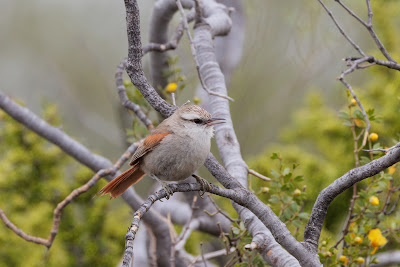Argentina: Pampas to Patagonia (Part 3: Bahia Blanca to Las Grutas to Puerto Madryn)
Oct 28
We completed the entire drive to Bahia Blanca the day before, so all we had was a short ride northwest of town to the pastures that PAMPAS MEADOWLARKS call home. Just a bit past the turnoff for Chasico we parked the car and focused on fields looking west. It didn't take long for a skylarking meadowlark with dark underwings to declare itself as a Pampas, though we had to take great care to separate these birds from the numerous LONG-TAILED MEADOWLARKS and scattered WHITE-BROWED MEADOWLARKS that also reside here. We spent a while soaking in this rare species that the three of us are unlikely to ever see again. Most of the time the Pampas kept their distance from the road, unlike the Long-taileds which had no such aversion.
 |
| Pampas Meadowlarks |
 |
| Long-tailed Meadowlark, for comparison |
Our second and final BEARDED TACHURI made a brief appearance along the fence line here. A pair of BURROWING PARAKEETS was a sign of many more to come over the next two days. GRASSLAND SPARROWS sang from the fenceposts.
 |
| Burrowing Parakeet |
 |
| Grassland Sparrow |
 |
| Burrowing Parakeets |
 |
| Burrowing Owl |
Once we were satisfied with our meadowlark experience, we headed towards Chasico in search of Pampas Pipit. I had two sets of coordinates I thought might be reliable, but there was no sign of them at either location. On our way back towards Route 35 we pulled over at what looked like suitable habitat, and Boom...displaying PAMPAS PIPITS could be heard over the wheat fields.
Pleased with our results through mid-morning, we attempted to bird side roads west of Route 35, where we officially left the Pampas and entered our second ecoregion: Espinal Woodland. Here the habitat transitions from grassland to dry thorny trees and scrub, and the birdlife significantly changes.
Access here proved more difficult than anticipated thanks to unexpectedly muddy conditions. We actually were able to barrel our poor car through the first couple patches of mud, but we eventually reached an impassable section and had to find alternate routes. Even the local authorities warned us not to proceed. But persistence pays off, and we found one particular road that looked good 'n safe.
This backroad gradually descended through a dry scrubby hillside that was incredibly birdy. The road started with a few singing FIREWOOD-GATHERERS tending to the large stick nests that give themselves their name. Deeper into the scrub we began to encounter WHITE-TIPPED PLANTCUTTERS, at least one of which always seemed within sight or earshot. This open-country cotinga's bizarre "song " would be played on loop for the next two hours.
 |
| Firewood-Gatherer |
 |
| White-tipped Plantcutter |
We became acquainted with a whole new suite of landbirds. CHACO EARTHCREEPER, TUFTED TIT-SPINETAIL, PALE-BREASTED SPINETAIL, STRANECK'S TYRANNULET and WHITE-CRESTED TYRANNULET were all present. Monjitas are a favorite of mine, so our first WHITE MONJITA was pretty sweet and looked entirely out of place, like a snowball in the desert.
We only scratched the surface of this habitat and easily could have spent a full day or more working our way through the network of dirt roads toward nearby lagunas and salinas. But we had an appointment to meet new friends who were caretakers of private land that would give us a shot at one of our most wanted targets.
Our Argentine friends were thrilled to show off their gem of a property. The pride they displayed for the wildlife on their land was refreshing, and their enthusiasm to share it was contagious. As we walked the trails in search of our quarry, we continued to pick up new birds. Two species we hoped to encounter along the road trip were Crested and Sandy Gallitos, dry country tapaculos that spend their lives on or near the ground. Fully prepped today for CRESTED GALLITO, we all perked up when we heard one calling from a trailside hedgerow. After some coaxing we nabbed decent views of a couple, and we estimated a half dozen on this walk.
A bit further down the path we heard a sweet emphatic warble that resembled the song of a Diuca Finch but was less emphatic with a slur and could only be one thing - YELLOW CARDINAL. We followed the song to find a pair of cardinals in the open across a lightly wooded area.
 |
| male |
 |
| male |
 |
| female |
This species is quite endangered, partially by habitat loss but mostly due to trapping for the illegal caged bird trade. Seeing and hearing the male in real life, one could understand the desire to keep this species as a pet. The disheartening story of their rapid demise is a reminder of how human greed and ignorance can put a common species on a path towards extinction. However there is hope in the form of conservationists and researchers who dedicate their lives to saving this species through a combination of habitat restoration, captive breeding, returning trapped birds to the wild, and public education regarding the issue at hand. Hats off to these wonderful human beings.
On our way out, we encountered multiple WHITE MONJITAS and our first BLACK-CROWNED MONJITAS as well. Needless to say, this place was a highlight of the tour.
After another productive stop further south, we hit the road again, this time bound for Las Grutas. Taking a look back, experiencing both Pampas Meadowlark and Yellow Cardinal in the same day was quite a feat. At this point we were feeling pretty good about choosing the road trip instead of flying over this part of the country.
Oct 29
After just one day spent in Espinal Woodland, we had entered yet another new biome: Monte Desert. Endemic to Argentina, this dry, sandy steppe holds yet another cohort of new species to seek.
At our first stop today, just north of Las Grutas town, we were hoping to find our second gallito species in as many days. The dry sagebrush-like habitat was home to the well-named Sandy Gallito, though it took some effort to locate a pair. In the meantime, we worked on other targets. Right away we spotted a WHITE-THROATED CACHALOTE teed up while our first GOLDEN-BILLED SALTATOR was singing away.
 |
| White-throated Cachalote |
 |
| Golden-billed Saltator |
SHARP-BILLED CANASTERO was our introduction the Asthenes and Pseudasthenes canasteros which look painfully alike. This ID problem, while not easy, wasn't quite as rough as feared as long as good looks and/or listens were involved. At least I think we didn't screw them up too much...!
We were also entering into arguably the finchiest portion of the journey, though we use the word "finch" very loosely given that I'm pretty sure the warbling finches and sierra finches are technically tanagers...but I digress! Our introduction to the sierra finches came in the form of a couple of CARBONATED SIERRA FINCHES here. While admiring this species at close range, we finally heard a SANDY GALLITO begin calling from a distance, where we eventually tracked down a cooperative pair.
 |
| Carbonated Sierra Finch |
With the gallito under our belts at a reasonable hour, and actually ahead of schedule against all odds, we decided to jog back north up Route 251 to a few roadside pins. At our first stop we were hoping for HUDSON'S BLACK-TYRANTS and boy did we find them. We had five individuals that were separable from the identical White-winged Black-Tyrant, plus another three that were very likely this species. All were males, perhaps recently arrived and setting up territories before the females appear.
The "finches" kept coming, as we encountered RINGED WARBLING FINCH, MOURNING SIERRA FINCH, and CINNAMON WARBLING FINCH, all new for us.
 |
| Stripe-crowned Spinetail |
Roadside stop #2 yielded SCALE-THROATED EARTHCREEPER, PALE-BREASTED SPINETAIL, and three more stunning WHITE MONJITAS.
Back near town on a dirt road near the gas station we were thrilled to find our only YELLOW-BILLED TIT-TYRANT of the trip and an impressive number of displaying CARBONATED SIERRA FINCHES.
 |
| Yellow-billed Tit-Tyrant |
 |
| Fork-tailed Flycatcher |
 |
| Fork-tailed Flycatcher |
We did so well north of town that we never even had to visit the arroyos south of town that most birders end up hitting for many of the species listed above. With a bit of extra time and no big rush to continue to the next region, we thought a seawatch from the beach could be fun. We found ourselves a nice dune with enough elevation to boost our visibility. The feature of our 15-minute vigil was a light movement of MANX SHEARWATERS well offshore. This was actually a lifer for landlubber Tripp!
 |
We also had our first looks at Golfo Nuevo, a sneak peek at the coastal experience we would enjoy during our stay here. Those first glimpses of water revealed a reasonably close fly-by GIANT-PETREL. And another. And another. And so it went. A slow trickle of giant-petrels, most SOUTHERN but one or two NORTHERN as well. With these results far from the open ocean, we were looking forward to what we might see from the Valdes Peninsula tomorrow.
We spent dusk at Punta Loma in hopes of spotting or hearing a Lesser Horned Owl. No dice there, but we did scope a couple of distant SOUTHERN RIGHT WHALES! By the time we left the park, it was dark. As we were about to hop into the car we heard the distant song of a BAND-WINGED NIGHTJAR (Austral subspecies). We tracked the bird as best we could but never viewed it. A second began calling from much closer but still managed to elude our line of sight. Running on fumes, we eventually gave up and headed for the barn.
 |
| Patagonian sunset |
- NB









Comments
Post a Comment